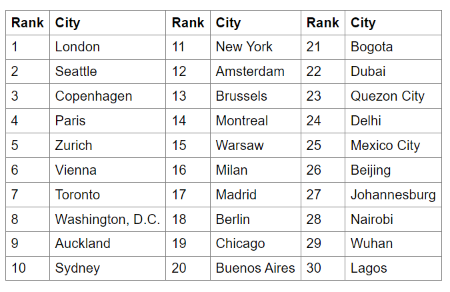|
Circular Cities Barometer showcases the world’s top 30 cities leading the shift to circular living. Image by Mohammed Shaheen, Upsplash |
| Holcim, a global leader in innovative and sustainable building solutions, has partnered with Bloomberg Media to launch the second edition of the Circular Cities Barometer, showcasing the world’s top cities leading the transition from a linear to a circular economy.
The Circular Cities Barometer also welcomes five new cities, including Vienna, Brussels, Buenos Aires, Washington, D.C. and Madrid, to bring the total to thirty. Jan Jenisch, Chairman & CEO of Holcim, noted that “with our world’s rapid urbanization, cities are at the center of the shift from a linear ‘take-make-waste’ economy to a circular ‘reduce-reuse-recycle’ one.” “Holcim is leading the transition to circular building,” he added. “By recycling construction demolition materials into new solutions across all key metropolitan areas where we operate. This Barometer is designed to fast-track circularity by offering unique insights into what the world’s most innovative circular cities are doing to inspire urban leaders worldwide”. Key indicators of circular cities include sustainable buildings with advanced certifications from LEED to BREEAM, broad-based use of renewable energy, people connected with many green mobility options, recycling hubs for materials to stay in use in closed loops and access to nature with high levels of tree cover inside cities. Urban planning and investments providing an enabling regulatory environment are vital levers cutting across all the most advanced circular cities. Several key themes emerge from this year’s rankings. Cities appear to be moving towards global alignment. Cities in the Global South, such as Bogota, Buenos Aires, and Quezon City, are joining several leading city-level organizations to be part of the international conversation. When it comes to scale, smaller cities like Copenhagen have a growing advantage over bigger cities such as Wuhan. Lastly, when financial incentives from entities like the World Bank are available, cities are more likely to sign up for circular initiatives and partnerships. As part of the newly launched Circular Cities Hub, a partnership between Holcim and Bloomberg Media, the Circular Cities Barometer measures how fast thirty global cities are transitioning from a linear to a circular economy. Broken by indicators, Zurich is the top city in the Barometer for circular living. Montreal and Seattle are the Barometer leaders in circular systems. London tops the Barometer for both circular living and circular building categories. The Barometer provides unique insights into what the most innovative cities worldwide are doing to become more circular and inspire others to join this movement to fast-track progress. Based on a proprietary algorithm, the Barometer scores cities based on the circularity of their buildings, systems, living and leadership. This year’s Barometer features a new indicator in the Circular Buildings category (Construction and Demolition Waste) and the Circular Leadership Category (Circular Procurement). The database showcases more than 300 best circularity practices from cities worldwide and is updated and expanded every year.
The Circular Cities Hub, a dynamic platform showcasing cities, ideas and projects accelerating the shift to circular living and building, is available here: https://bloomberg.com/ For more details on how Holcim is helping build circular cities, see: https://www.holcim.com/what- |
![]()







